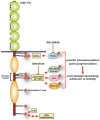Promotion of Tumor Invasion by Tumor-Associated Macrophages: The Role of CSF-1-Activated Phosphatidylinositol 3 Kinase and Src Family Kinase Motility Signaling
- PMID: 28629162
- PMCID: PMC5483887
- DOI: 10.3390/cancers9060068
Promotion of Tumor Invasion by Tumor-Associated Macrophages: The Role of CSF-1-Activated Phosphatidylinositol 3 Kinase and Src Family Kinase Motility Signaling
Abstract
Macrophages interact with cells in every organ to facilitate tissue development, function and repair. However, the close interaction between macrophages and parenchymal cells can be subverted in disease, particularly cancer. Motility is an essential capacity for macrophages to be able to carry out their various roles. In cancers, the macrophage's interstitial migratory ability is frequently co-opted by tumor cells to enable escape from the primary tumor and metastatic spread. Macrophage accumulation within and movement through a tumor is often stimulated by tumor cell production of the mononuclear phagocytic growth factor, colony-stimulating factor-1 (CSF-1). CSF-1 also regulates macrophage survival, proliferation and differentiation, and its many effects are transduced by its receptor, the CSF-1R, via phosphotyrosine motif-activated signals. Mutational analysis of CSF-1R signaling indicates that the major mediators of CSF-1-induced motility are phosphatidyl-inositol-3 kinase (PI3K) and one or more Src family kinase (SFK), which activate signals to adhesion, actin polymerization, polarization and, ultimately, migration and invasion in macrophages. The macrophage transcriptome, including that of the motility machinery, is very complex and highly responsive to the environment, with selective expression of proteins and splice variants rarely found in other cell types. Thus, their unique motility machinery can be specifically targeted to block macrophage migration, and thereby, inhibit tumor invasion and metastasis.
Keywords: Src family kinases; colony-stimulating factor-1; macrophage motility; paracrine interaction; phosphatidyl-inositol-3-kinase.
Conflict of interest statement
The authors declare no conflict of interest.
Figures



Similar articles
-
Phosphorylation of CSF-1R Y721 mediates its association with PI3K to regulate macrophage motility and enhancement of tumor cell invasion.J Cell Sci. 2011 Jun 15;124(Pt 12):2021-31. doi: 10.1242/jcs.075309. Epub 2011 May 24. J Cell Sci. 2011. PMID: 21610095 Free PMC article.
-
Fibronectin induces macrophage migration through a SFK-FAK/CSF-1R pathway.Cell Adh Migr. 2017 Jul 4;11(4):327-337. doi: 10.1080/19336918.2016.1221566. Epub 2016 Sep 2. Cell Adh Migr. 2017. PMID: 27588738 Free PMC article.
-
Src family kinase expression and subcellular localization in macrophages: implications for their role in CSF-1-induced macrophage migration.J Leukoc Biol. 2016 Jul;100(1):163-75. doi: 10.1189/jlb.2A0815-344RR. Epub 2016 Jan 8. J Leukoc Biol. 2016. PMID: 26747837
-
The role of macrophage migratory behavior in development, homeostasis and tumor invasion.Front Immunol. 2024 Nov 11;15:1480084. doi: 10.3389/fimmu.2024.1480084. eCollection 2024. Front Immunol. 2024. PMID: 39588367 Free PMC article. Review.
-
CSF-1 signaling in macrophages: pleiotrophy through phosphotyrosine-based signaling pathways.Crit Rev Clin Lab Sci. 2012 Mar-Apr;49(2):49-61. doi: 10.3109/10408363.2012.666845. Crit Rev Clin Lab Sci. 2012. PMID: 22468857 Review.
Cited by
-
The Activity of Novel BCR-ABL Small-Molecule Degraders Containing Pyrimidine Rings and Their Role in Overcoming Drug Resistance.J Oncol. 2022 Oct 30;2022:4056398. doi: 10.1155/2022/4056398. eCollection 2022. J Oncol. 2022. PMID: 36349200 Free PMC article.
-
Targeting tumor-associated macrophages for cancer treatment.Cell Biosci. 2022 Jun 7;12(1):85. doi: 10.1186/s13578-022-00823-5. Cell Biosci. 2022. PMID: 35672862 Free PMC article. Review.
-
Challenges and prospects of CSF1R targeting for advanced malignancies.Am J Cancer Res. 2023 Jul 15;13(7):3257-3265. eCollection 2023. Am J Cancer Res. 2023. PMID: 37560003 Free PMC article.
-
Effects of the interactions between platelets with other cells in tumor growth and progression.Front Immunol. 2023 Apr 17;14:1165989. doi: 10.3389/fimmu.2023.1165989. eCollection 2023. Front Immunol. 2023. PMID: 37153586 Free PMC article. Review.
-
EMT and Tumor Turning Point Analysis in 3D Spheroid Culture of HNSCC and Mesenchymal Stem Cells.Biomedicines. 2022 Dec 19;10(12):3283. doi: 10.3390/biomedicines10123283. Biomedicines. 2022. PMID: 36552039 Free PMC article.
References
-
- Xue J., Schmidt S.V., Sander J., Draffehn A., Krebs W., Quester I., De Nardo D., Gohel T.D., Emde M., Schmidleithner L., et al. Transcriptome-based network analysis reveals a spectrum model of human macrophage activation. Immunity. 2014;40:274–288. doi: 10.1016/j.immuni.2014.01.006. - DOI - PMC - PubMed
Publication types
LinkOut - more resources
Full Text Sources
Other Literature Sources
Research Materials
Miscellaneous

